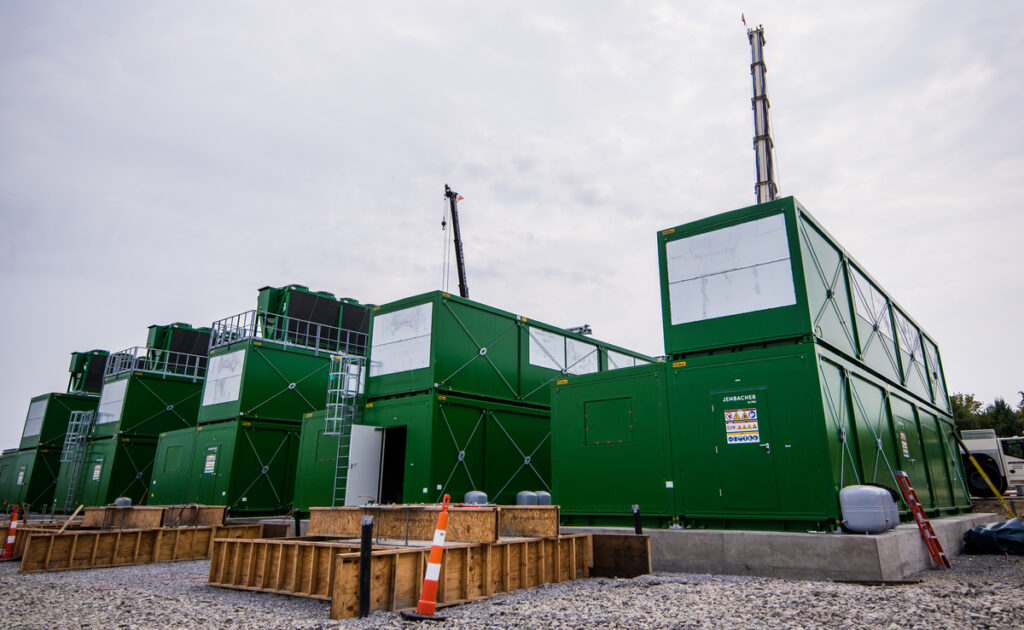Construction Update: Crews ‘Right on Track’ With PIT Microgrid Project
First-of-its kind electrical grid to completely power Pittsburgh airport by summer 2021
By Natalie Fiorilli
Published September 28, 2020
Read Time: 3 mins
Pittsburgh International Airport’s plan to become the first major airport to be completely powered by its own microgrid moved a step closer to completion this month as crews installed the generators that will help power the facility.
The five bright green, 100-ton natural-gas-fired generators sit in a row on a construction site at PIT. The one-acre pad will soon power the entire airport facility.
In October 2019, airport officials first announced plans for the microgrid, and crews broke ground on the project this summer.
When complete, the microgrid will be capable of producing enough energy to power more than 13,000 residential homes, an equivalent of more than 23 megawatts of electricity. The project is expected to lower the cost of electricity to the airport and its tenants while making PIT one of the most site-hardened airports in the world.
Tom Woodrow, Vice President of Engineering at PIT, explained that plans for the microgrid came after a number of major airports experienced power blackouts that resulted in flight cancellations and other disruptions.
“In seeing other airports experience outages, we realized the value of having resiliency here at PIT,” Woodrow said. “The value of maintaining operations at the airport is hard to quantify. It’s priceless, really.”
A microgrid is an independent electricity source that can operate autonomously. Essentially, a microgrid adds reliability and resilience for a facility like an airport because it has the ability to support critical loads in the instance of a traditional grid outage or other threat to operations.

The 100-ton Jenbacher natural gas-fired generators will produce 20 megawatts of electricity. (Photo by Beth Hollerich)
At PIT, the microgrid will serve as the primary power source of electricity for the airport, including both terminals, the airfield, the Hyatt hotel and the Sunoco gas station. The airport will also remain connected to the traditional electrical grid for emergency or backup power if needed.
Pittsburgh-based Peoples Natural Gas, an Essential Utilities company, is tasked with building, operating and maintaining the microgrid at no cost to the airport other than electrical bills. The facility will be powered by the five natural-gas-fired generators and more than 9,000 solar panels.
In addition to Peoples and construction company PJ Dick, other companies working on the project include LLI Engineering, Northeast Energy Systems, IMG Energy Services, EIS Solar, Sheffler and Company, McK Construction, Ran-Den Excavating, Sargent Electric Company and McKamish Inc.
“I’ve never worked on such a compact project with such a small footprint that generates this much power,” said Rich Celani, superintendent of the project for PJ Dick.
Since installing the Jenbacher generators, workers are nearly finished with the first phase of construction, involving installation of the generators and the natural gas supply.
“Every time you come here, something new has been installed,” Celani added. “We’re right on track with everything.”
Next, exhaust systems will be added to the generators and then work will begin on piping and wiring the generators. The last phase of the project will involve connecting wiring from the site to the airport’s main substation through underground conduits.
Simultaneously, crews will begin working to install the solar panels at a different location that will provide additional energy for the airport’s facilities.
The microgrid is expected to be operational by June 2021.
Watch
This Next
Read
This Next





